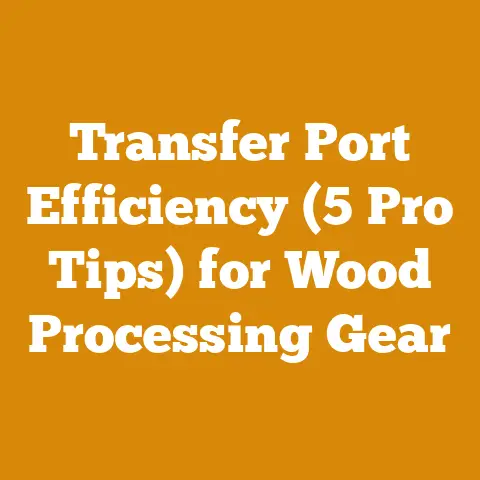Scotch Pine Structural Timbers (5 Strength Facts Every Miller Must Know)
Scotch Pine Structural Timbers: 5 Strength Facts Every Miller Must Know
Scotch Pine (Pinus sylvestris) is a versatile and widely distributed softwood species, and understanding its structural properties is paramount for any miller venturing into timber production.
It’s not just about sawing logs; it’s about understanding the material you’re working with and ensuring it meets the required standards for its intended use.
1. Bending Strength (Modulus of Rupture – MOR)
Bending strength, often represented by the Modulus of Rupture (MOR), indicates a timber’s ability to resist bending forces before fracturing.
For Scotch Pine, the MOR typically ranges from 8,000 to 12,000 psi (55 to 83 MPa), depending on factors like growth rate, knot density, and moisture content.
- Why it matters: This is critical for beams, rafters, and joists, where the timber is subjected to significant bending loads.
- Miller’s perspective: When selecting Scotch Pine logs, I always look for tighter growth rings, which generally indicate higher density and, consequently, greater MOR.
Avoid logs with excessive knots, especially large ones clustered together, as these significantly weaken the timber’s bending resistance. - Cost implications: Timbers with higher MOR potential command a premium price.
Sourcing logs from older, slower-growing stands can increase material costs but reduces the risk of structural failure and potential liability.
Investing in proper grading and sorting equipment can also justify higher prices for stronger timber.
2. Stiffness (Modulus of Elasticity – MOE)
The Modulus of Elasticity (MOE) measures a timber’s resistance to deformation under load.
A higher MOE means the timber is stiffer and will deflect less under a given force.
Scotch Pine typically exhibits an MOE between 1.2 million and 1.6 million psi (8.3 to 11 GPa).
- Why it matters: Stiffness is essential for floor joists and roof rafters, where excessive deflection can lead to bouncy floors or sagging roofs.
- Miller’s perspective: In my experience, MOE is significantly affected by moisture content.
Kiln-drying Scotch Pine to a moisture content of around 12-15% dramatically improves its stiffness compared to green lumber.
This is a crucial step for structural applications. - Cost implications: Kiln-drying adds significantly to the processing costs.
A typical small-scale kiln can cost anywhere from $5,000 to $20,000, depending on its capacity and automation level.
The energy costs for running the kiln also need to be factored in.
However, the increased value of kiln-dried timber often justifies the investment.
3. Compressive Strength (Parallel to Grain)
Compressive strength parallel to the grain measures a timber’s ability to withstand crushing forces when the load is applied along the grain.
Scotch Pine typically has a compressive strength of 5,000 to 8,000 psi (34 to 55 MPa).
- Why it matters: This is critical for posts, columns, and studs, where the timber is subjected to axial compression.
- Miller’s perspective: I’ve found that the compressive strength of Scotch Pine is less variable than its bending strength.
However, it’s still essential to avoid logs with decay or internal defects, as these can significantly reduce compressive resistance.
End-grain inspection is crucial. - Cost implications: Logs suitable for posts and columns require careful selection and may come at a slightly higher price.
However, the cost of failure due to inadequate compressive strength can be catastrophic, making quality control paramount.
4. Shear Strength
Shear strength measures a timber’s ability to resist forces that cause it to slide or shear along the grain.
Scotch Pine generally has a shear strength of 700 to 1,200 psi (4.8 to 8.3 MPa).
- Why it matters: Shear strength is important in areas where fasteners (nails, screws, bolts) are used to connect timber members.
It determines the timber’s resistance to being pulled apart at the connection points. - Miller’s perspective: In my experience, shear strength is often overlooked but can be a critical factor in timber frame construction.
Proper joinery techniques, such as mortise and tenon, are essential to maximize the shear resistance of Scotch Pine timbers. - Cost implications: Utilizing more complex joinery techniques requires skilled labor, which translates to higher construction costs.
However, it can also reduce the need for expensive metal connectors and improve the overall structural integrity of the building.
5. Density
Density is a fundamental property that influences all other strength characteristics.
Scotch Pine typically has a density of 30 to 35 pounds per cubic foot (480 to 560 kg/m3) at 12% moisture content.
1. Timber Purchase or Harvesting Costs
The cost of acquiring the raw timber is a significant factor in the overall economics of Scotch Pine structural timbers.
This can involve purchasing logs from a timber supplier or harvesting your own timber from a managed forest.
- Purchasing Logs: The price of Scotch Pine logs can vary widely depending on the grade, diameter, length, and availability.
As of 2024, I’ve seen prices ranging from $0.30 to $0.80 per board foot for sawlogs suitable for structural timber production.
This translates to roughly $300 to $800 per thousand board feet (MBF).- Factors influencing log prices:
- Grade: Higher-grade logs with fewer knots and defects command a premium price.
- Diameter: Larger-diameter logs generally yield more usable timber and are therefore more valuable.
- Length: Longer logs are often required for specific structural applications and may be more expensive.
- Location: Timber prices vary significantly depending on the region and local market conditions.
- Seasonality: Prices can fluctuate depending on the time of year, with higher prices often seen during the peak construction season.
- Factors influencing log prices:
- Harvesting Your Own Timber: If you have access to a managed forest, harvesting your own timber can potentially reduce costs.
However, it also involves significant expenses for logging equipment, labor, and permits.- Logging Equipment Costs:
- Chainsaw: A professional-grade chainsaw suitable for felling and bucking logs can cost between $800 and $1,500.
- Skidder: A skidder for moving logs from the forest to the landing can range from $20,000 to $100,000 or more, depending on its size and features.
Renting a skidder is also an option, with daily rates typically ranging from $300 to $800. - Log Loader: A log loader for loading logs onto trucks can cost between $50,000 and $200,000.
Renting a log loader is also possible, with daily rates ranging from $500 to $1,200.
- Labor Costs: Logging labor costs vary depending on the region and skill level of the workers.
A typical logging crew might consist of a feller, a skidder operator, and a log loader operator.
Hourly wages can range from $20 to $40 per hour per worker. - Permit Costs: Harvesting timber often requires permits from local or state authorities.
Permit fees can vary widely depending on the location and the size of the harvest. - My Experience: I’ve found that harvesting my own timber can be cost-effective for smaller projects, but it requires a significant investment in equipment and expertise.
For larger projects, purchasing logs from a reputable supplier is often the more economical option.
- Logging Equipment Costs:
2. Milling Costs
Once you have the logs, the next step is milling them into structural timbers.
This involves using a sawmill to saw the logs into the desired dimensions.
- Sawmill Options:
- Portable Sawmill: A portable sawmill is a versatile option for milling timber on-site.
Portable sawmills can range in price from $5,000 to $50,000 or more, depending on their size and features.
Renting a portable sawmill is also an option, with daily rates typically ranging from $200 to $500. - Commercial Sawmill: A commercial sawmill is a larger, more automated facility that can process a high volume of logs.
Hiring a commercial sawmill to mill your logs can cost between $0.15 and $0.30 per board foot.
- Portable Sawmill: A portable sawmill is a versatile option for milling timber on-site.
- Milling Labor Costs: If you are operating your own sawmill, you will need to factor in labor costs.
Sawmill operators typically earn between $20 and $35 per hour. - Saw Blade Costs: Saw blades are a consumable item that needs to be replaced periodically.
The cost of a saw blade can range from $50 to $500 or more, depending on the size and type of blade. - Fuel and Maintenance Costs: Sawmills require fuel to operate, and they also need regular maintenance.
Fuel costs can range from $10 to $50 per hour, depending on the size and type of sawmill.
Maintenance costs can range from $100 to $1,000 per year, depending on the age and condition of the sawmill. - My Experience: I started with a small portable sawmill and gradually upgraded to a larger model as my business grew.
I’ve found that proper maintenance is crucial for keeping the sawmill running smoothly and minimizing downtime.
3. Drying Costs
After milling, the timbers need to be dried to reduce their moisture content.
This is essential for preventing warping, cracking, and decay.
- Drying Methods:
- Air Drying: Air drying is the most traditional method of drying timber.
It involves stacking the timbers in a well-ventilated area and allowing them to dry naturally.
Air drying can take several months or even years, depending on the climate and the thickness of the timbers. - Kiln Drying: Kiln drying is a faster and more controlled method of drying timber.
It involves placing the timbers in a kiln and using heat and air circulation to remove moisture.
Kiln drying can take several days or weeks, depending on the species of wood and the desired moisture content.
- Air Drying: Air drying is the most traditional method of drying timber.
- Air Drying Costs: The costs associated with air drying are relatively low.
They primarily involve the cost of the land used for stacking the timbers and the labor required to stack and monitor the drying process. - Kiln Drying Costs: Kiln drying is more expensive than air drying due to the energy costs involved in heating and circulating the air.
The cost of kiln drying can range from $0.10 to $0.30 per board foot, depending on the size of the kiln and the energy source. - My Experience: I’ve used both air drying and kiln drying, and I’ve found that kiln drying is essential for producing high-quality structural timbers.
While it is more expensive, it allows me to control the moisture content and ensure that the timbers are stable and durable.
I invested in a small solar kiln to reduce my energy costs and minimize my environmental impact.
4. Grading and Sorting Costs
Grading and sorting are essential for ensuring that the timbers meet the required structural standards.
This involves inspecting the timbers for defects and sorting them according to their strength and appearance.
- Grading Standards: Structural timbers are typically graded according to industry standards, such as those established by the National Lumber Grades Authority (NLGA) in North America or similar organizations in other regions.
- Grading Labor Costs: Grading labor costs vary depending on the skill level of the graders.
Experienced graders can earn between $25 and $45 per hour. - Equipment Costs: Grading may require equipment such as moisture meters, calipers, and straight edges.
The cost of this equipment can range from $100 to $1,000. - My Experience: I’ve found that proper grading is essential for ensuring the quality and safety of my structural timbers.
I invested in training for my employees to become certified graders, and I regularly calibrate my grading equipment to ensure accuracy.
5. Handling and Transportation Costs
Handling and transportation costs involve the labor and equipment required to move the timbers from one location to another.
This can include loading, unloading, and transporting the timbers to the customer’s site.
- Equipment Costs:
- Forklift: A forklift is essential for loading and unloading timbers.
Forklifts can range in price from $20,000 to $100,000 or more, depending on their size and capacity.
Renting a forklift is also an option, with daily rates typically ranging from $200 to $500. - Truck: A truck is required for transporting the timbers to the customer’s site.
The cost of a truck can range from $30,000 to $150,000 or more, depending on its size and features.
- Forklift: A forklift is essential for loading and unloading timbers.
- Labor Costs: Handling and transportation labor costs vary depending on the region and the skill level of the workers.
Laborers can earn between $15 and $30 per hour. - Fuel Costs: Fuel costs can be a significant factor in transportation costs, especially for long distances.
- My Experience: I’ve found that efficient handling and transportation are essential for minimizing costs and ensuring that the timbers arrive at the customer’s site in good condition.
I invested in a forklift and a flatbed truck to streamline my handling and transportation operations.
6. Marketing and Sales Costs
Marketing and sales costs involve the expenses associated with promoting and selling your structural timbers.
This can include advertising, website development, sales commissions, and other marketing expenses.
- Advertising Costs: Advertising costs can vary widely depending on the media used.
Online advertising can range from $1 to $10 per click, while print advertising can cost several hundred dollars per ad. - Website Development Costs: Developing a professional website can cost between $1,000 and $10,000 or more, depending on the complexity of the site.
- Sales Commissions: Sales commissions are typically a percentage of the sales price.
They can range from 5% to 15%, depending on the industry and the sales representative’s experience. - My Experience: I’ve found that a strong online presence is essential for attracting customers.
I invested in a professional website and I actively use social media to promote my structural timbers.
7. Overhead Costs
Overhead costs are the indirect expenses associated with running your business.
This can include rent, utilities, insurance, and administrative expenses.
- Rent: Rent can vary widely depending on the location and the size of the facility.
- Utilities: Utility costs can include electricity, gas, water, and sewer.
- Insurance: Insurance costs can include property insurance, liability insurance, and workers’ compensation insurance.
- Administrative Expenses: Administrative expenses can include salaries for administrative staff, office supplies, and accounting fees.
- My Experience: I’ve found that it’s important to carefully track my overhead costs and look for ways to reduce them.
I switched to energy-efficient lighting and I negotiated lower rates with my insurance providers.
Total Cost Calculation: An Example
Let’s put it all together with an example.
Suppose I’m producing 1,000 board feet of Scotch Pine structural timbers for a small timber frame project.
- Timber Purchase: $500 (at $0.50/board foot)
- Milling: $200 (at $0.20/board foot)
- Kiln Drying: $150 (at $0.15/board foot)
- Grading and Sorting: $50
- Handling and Transportation: $100
- Marketing and Sales: $50
- Overhead: $100
Total Cost: $1,150
This translates to a cost of $1.15 per board foot.
To make a profit, I would need to sell the timbers for more than this amount.
The selling price would depend on the market demand, the quality of the timbers, and the competition.
Industry Benchmarks: According to industry reports, the average selling price for softwood structural timbers ranges from $1.50 to $3.00 per board foot.
This suggests that my cost structure is competitive, but I would need to carefully monitor my expenses and adjust my pricing strategy to maximize my profitability.
Practical Tips for Cost Optimization and Budget Management
Producing Scotch Pine structural timbers can be a profitable venture, but it requires careful planning and cost management.
Here are some practical tips for optimizing your costs and staying within budget:
- Source Timber Strategically: Negotiate favorable prices with timber suppliers or explore the possibility of harvesting your own timber.
- Invest in Efficient Equipment: Choose equipment that is appropriate for your scale of operation and that is energy-efficient.
- Minimize Waste: Optimize your milling practices to minimize waste and maximize the yield from each log.
- Control Drying Costs: Use air drying whenever possible to reduce energy costs.
- Implement a Quality Control Program: Ensure that your timbers meet the required structural standards to avoid costly rework.
- Streamline Handling and Transportation: Invest in efficient handling and transportation equipment to minimize labor costs.
- Develop a Marketing Plan: Target your marketing efforts to reach the right customers and maximize your sales.
- Track Your Costs: Carefully track all of your costs and identify areas where you can reduce expenses.
- Build Relationships: Building long-term relationships with suppliers and customers can lead to better pricing and more consistent business.
- Continuous Improvement: Continuously evaluate your processes and look for ways to improve efficiency and reduce costs.
Relevant Calculations and Formulas
Understanding basic calculations and formulas is essential for managing costs and optimizing your timber production process.
Board Foot Calculation: A board foot is a unit of measurement for lumber that is 1 inch thick, 12 inches wide, and 12 inches long.
The formula for calculating board feet is:(Thickness in inches x Width in inches x Length in inches) / 144
For example, a timber that is 2 inches thick, 8 inches wide, and 10 feet long would contain:
(2 x 8 x 120) / 144 = 13.33 board feet
Cubic Foot Calculation: A cubic foot is a unit of measurement for volume that is 1 foot long, 1 foot wide, and 1 foot high.
The formula for calculating cubic feet is:(Length in feet x Width in feet x Height in feet)
For example, a stack of logs that is 10 feet long, 5 feet wide, and 4 feet high would contain:
10 x 5 x 4 = 200 cubic feet
Moisture Content Calculation: Moisture content is the percentage of water in wood.
It is calculated using the following formula:((Wet Weight – Dry Weight) / Dry Weight) x 100
For example, if a piece of wood weighs 100 grams when wet and 80 grams when dry, its moisture content would be:
((100 – 80) / 80) x 100 = 25%
Estimating Drying Time: The time it takes for timber to dry depends on several factors, including the species of wood, the thickness of the timber, the climate, and the drying method.
A general rule of thumb is that air drying takes about one year per inch of thickness.
Kiln drying can take several days or weeks, depending on the specific drying schedule.
Case Studies: Budgeting and Cost Management in Wood Harvesting
Let’s look at a couple of case studies to illustrate how budgeting and cost management can impact the success of wood harvesting or firewood preparation projects.
Case Study 1: Small-Scale Logger in the Pacific Northwest
A small-scale logger in the Pacific Northwest wanted to harvest timber from a 20-acre parcel of land.
He developed a detailed budget that included the following costs:
- Permit Fees: $500
- Logging Equipment Rental: $2,000
- Labor Costs: $5,000
- Transportation Costs: $1,000
- Total Costs: $8,500
He estimated that he could harvest 100,000 board feet of timber, which he could sell for $1.00 per board foot.
This would generate revenue of $100,000.
- Revenue: $100,000
- Costs: $8,500
- Profit: $91,500
However, the logger encountered several unexpected challenges during the project.
The weather was wetter than usual, which made it difficult to operate the logging equipment.
He also had to pay higher labor costs because he couldn’t find enough experienced loggers.
As a result, his actual costs were higher than his budgeted costs.
- Actual Costs: $12,000
- Profit: $88,000
Despite the challenges, the logger was still able to make a profit.
However, his profit was lower than he had originally anticipated.
This case study illustrates the importance of developing a realistic budget and being prepared for unexpected challenges.
Case Study 2: Firewood Supplier in the Northeastern United States
A firewood supplier in the Northeastern United States wanted to increase his production capacity.
He developed a budget to purchase a new firewood processor.
- Firewood Processor Purchase: $25,000
- Installation Costs: $1,000
- Operating Costs (per cord): $20
He estimated that he could produce 500 cords of firewood per year, which he could sell for $200 per cord.
- Revenue (per year): $100,000
- Operating Costs (per year): $10,000
- Gross Profit (per year): $90,000
He calculated that the new firewood processor would pay for itself in less than one year.
However, he failed to account for the cost of financing the purchase.
He had to borrow money to buy the firewood processor, and he had to pay interest on the loan.
- Interest Payments (per year): $3,000
- Net Profit (per year): $87,000
The interest payments reduced his net profit, and it took him longer to pay off the loan.
This case study illustrates the importance of considering all costs, including financing costs, when making a capital investment.
Actionable Takeaways and Next Steps
Producing Scotch Pine structural timbers can be a rewarding and profitable venture.
By understanding the strength characteristics of the wood, carefully managing your costs, and implementing efficient production practices, you can create a successful business.
Here are some actionable takeaways and next steps:
- Research Local Market Conditions: Understand the demand for structural timbers in your area and identify your target customers.
- Develop a Detailed Business Plan: Outline your business goals, strategies, and financial projections.
- Secure Funding: Explore financing options, such as loans or grants, to fund your startup costs.
- Invest in Training: Acquire the necessary skills and knowledge to operate your equipment and manage your business effectively.
- Build Relationships: Network with other professionals in the timber industry, such as loggers, sawmill operators, and builders.
- Start Small: Begin with a small-scale operation and gradually expand as your business grows.
- Continuously Improve: Stay up-to-date on the latest industry trends and technologies and look for ways to improve your efficiency and profitability.
By following these steps, you can increase your chances of success in the Scotch Pine structural timber business.
Remember, it’s a journey that requires dedication, hard work, and a passion for wood.






